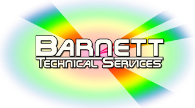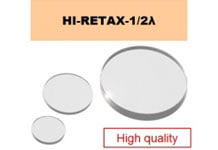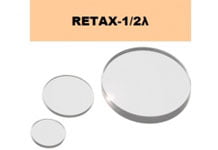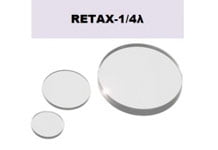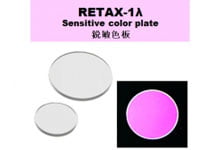Wave plates, also known as retarder plates, are optical devices that have different refractive indices for different polarization states. These devices change the state of light passing through them, and the polarization state varies based on the plate properties. Waveplates are made of anisotropic or birefringent materials, wherein an incoming ray is refracted in two directions. Also, birefringent materials can be glued to optical glass. Barnett Technical Services is an authorized distributor of Luceo products, including their waveplates.
Wave Plates
Products
HI-RETAX is the wavelength phase difference plate which bonded a wavelength film with the ..
Read More..HI-RETAX is the wavelength phase difference plate which bonded a wavelength film with the ..
Read More..RETAX is the wavelength phase difference plate which bonded a wavelength film with the bir..
Read More..RETAX is the wavelength phase difference plate which bonded a wavelength film with the bir..
Read More..RETAX is the wavelength phase difference plate which bonded a wavelength film with the bir..
Read More..About Luceo Wave Plates
When linearly polarized light at a specific wavelength passes through these wave plates, it is converted into a designated retardance. Luceo makes various wave plates for each specific wavelength of incident light. Luceo has developed RETAX, a series of waveplates, which enable achieving a specific retardance. This is truly an optical innovation as the plates have processable birefringent resin film glued within optical glass plates. Their range of retardation is 30nm ~ 550nm.Luceo RETAX Series Wave Plates Products
RETAX waveplates comprise a film made of birefringent materials is glued to the glass plate. Luceo’s lineup of RETAX wave plates for specific wavelength and broadband wavelength range. Here are the types of wave plates by Luceo we offer- HI-RETAX-1/2λ: This plate comprises a thermostable birefringent resin film within optical glass plates, which is functional at reasonably high temperatures.
- RETAX-1λ: This is a full retardance sensitive color plate with 530nm phase difference.
- RETAX-1/2λ: Half retardance is realized for visible light of any wavelength when linearly polarized light passes through this wave plate.
- RETAX-1/4λ: This wave plate has a resin film which realizes 1/4 retardance of any wavelength for the visible light range with 1 pc.
- HI-RETAX-1/4λ: This plate comprises a thermostable birefringent resin film within optical glass plates, which is functional at around 70℃. HI-RETAX has less retardation change, better orientation, and stable retardation in-plane. A similar hue as a crystal and mica wave plate is realized under polarizing observation with HI-RETAX-1λ-plate.
Function of Luceo RETAX Series Wave Plates
Here are the functions of Luceo RETAX series wave plates.- Quarter-Waveplates (1/4-waveplates): 1/4 waveplate enables a quarter retardance to the incident light. For a circular polarizing plate, 1/4 waveplate is combined with a linear polarizer. A circularly polarizing plate has a function of an isolator to block reflection light from a reflection plane. This is because incident light may enter the circularly polarizing plate, reflecting the outgoing light on the reflection plane, and re-enter the circularly polarizing plate. These wave plates turn circularly polarized light into linearly polarized light and vice versa.
- Half-Waveplates (1/2-waveplate): 1/2 waveplate realizes a half retardance to incident light. When linearly polarized light enters a half wave plate at an angle of 45 degrees to an optical axis, the outgoing light becomes linearly polarized, and the vibration direction is rotated by 90 degrees to the initial vibration direction of the incident light. On the other hand, when circularly polarized light enters a half wave plate, the outgoing light direction is reverse rotated.
- Full Waveplates: This 1-lambda wave plate of RETAX & HI-RETAX is called a sensitive color plate, which has a wavelength of 530nm. When 1-lambda wave plate is set between two polarizers placed cross to each other, the white light which passes the polarizers and 1-lambda wave plate, is changed to bluish-purple light. So, this wave plate is color-sensitive and also known as full retardation or color tint plate.
Applications of Wave Plates
Here are some applications of RETAX wave plates.- Optical communication: Wave plates are used in fiber optic network devices to control the polarization of light.
- Optical isolation: Here, waveplates help prevent back reflection and can be used alongside polarizers, wherein light passes in one direction and is blocked in the opposite direction. This achieves optical isolation.
- Polarimetry: Wave plates are a part of polarimeters to help analyze polarization state, degree, orientation, and more.
- Spectroscopy: Wave plates find application in spectroscopic instruments to modify or manipulate the polarization state before it interacts with the material.
- Microscopy: Wave plates are used to control the polarization of light in fluorescence and polarization microscopy to reduce glare, improve image contrast, and more.
Advantages of Using Waveplates
Some benefits of using Luceo waveplates.- Luceo offers custom options for waveplates in terms of material, shape, size, thickness, and so on, besides our offerings with standard features.
- Luceo waveplates utilize a resin film, and therefore over 30mm diameter products are fabricated. We cater to changing wavelength range by designing the wave plate optically.
- The main benefit of waveplates is polarization control, which helps optimize optical signals.
- Waveplates are compact and lightweight and hence can be easily integrated into a wide range of products and systems.
- Depending on their design and specifications, waveplates can provide a wide range of polarization manipulation capabilities, including rotation, conversion between linear and circular polarization, and control of ellipticity.
- Luceo retarder plates are designed for high-temperature environments. They are compatible with various types of light sources, including lasers, LEDs, and natural light. They remain stable under varied operating environments.
